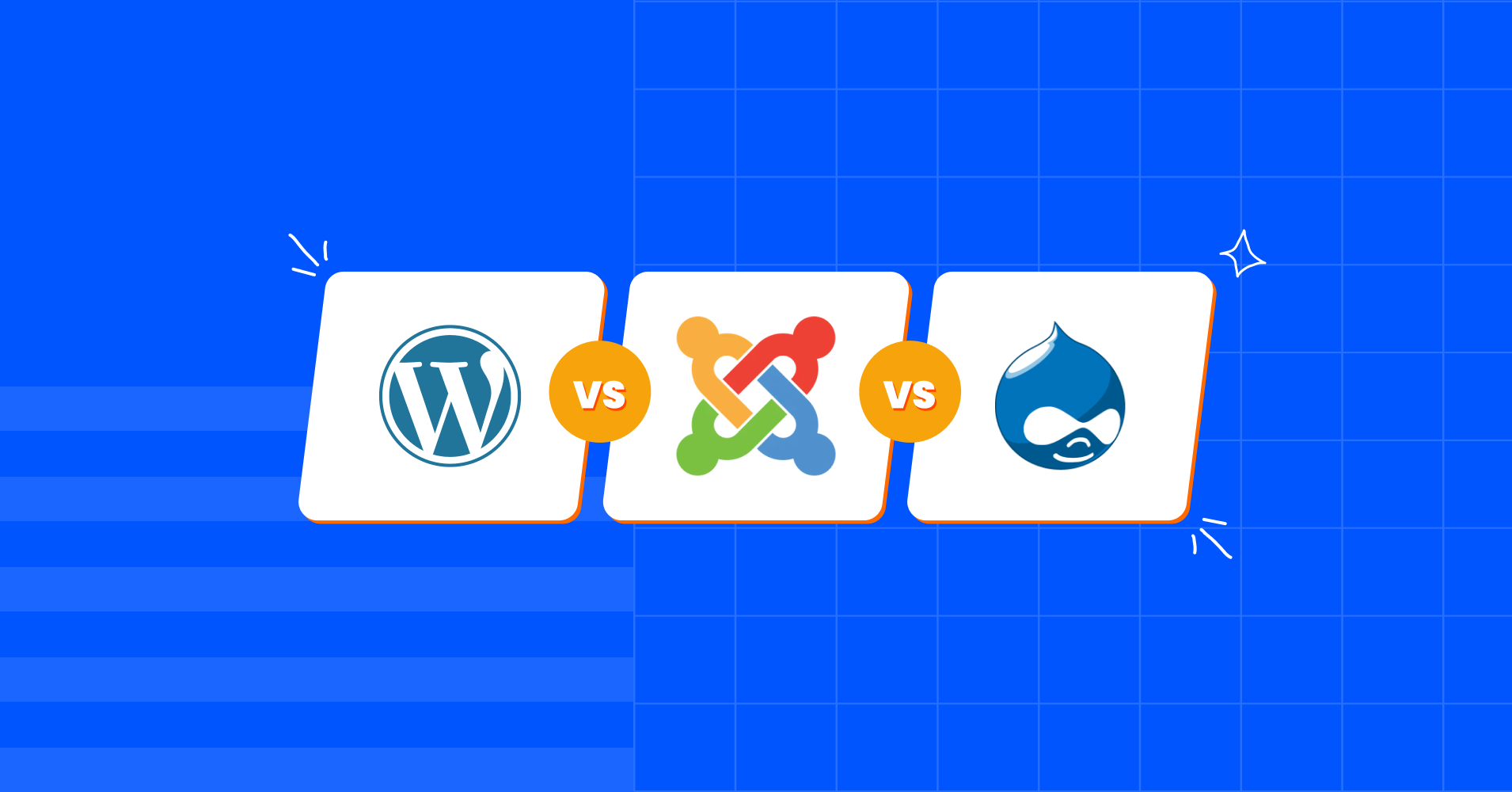
WordPress vs Joomla vs Drupal: Which CMS is Best for You in 2025?
Share :

We will never spam you. We will only send you product updates and tips.
WordPress is the most popular CMS, currently empowering 43% of all websites created in the world. Despite being the most popular, some people still don’t like to adapt to WordPress because of things like the learning curve and plugin dependency.
Recent controversies around Matt Mullenweg, WordPress’s founder (dubbed WPDrama), have caused some users to explore alternatives. Rest assured, WordPress’s global community keeps it strong and reliable.
Even the uncertainty evokes a second thought in WordPress lovers. However, WordPress is going nowhere, at least in a quick span of time.
With WPDrama sparking interest in alternatives, we’re comparing Drupal, WordPress, and Joomla. Each has unique strengths and weaknesses, making it easier to pick the right one for your project.
In this post, we’re going to look deeper across multiple platforms to understand the differences and whether the solution suits your needs.
WordPress vs Drupal vs Joomla: a short introduction
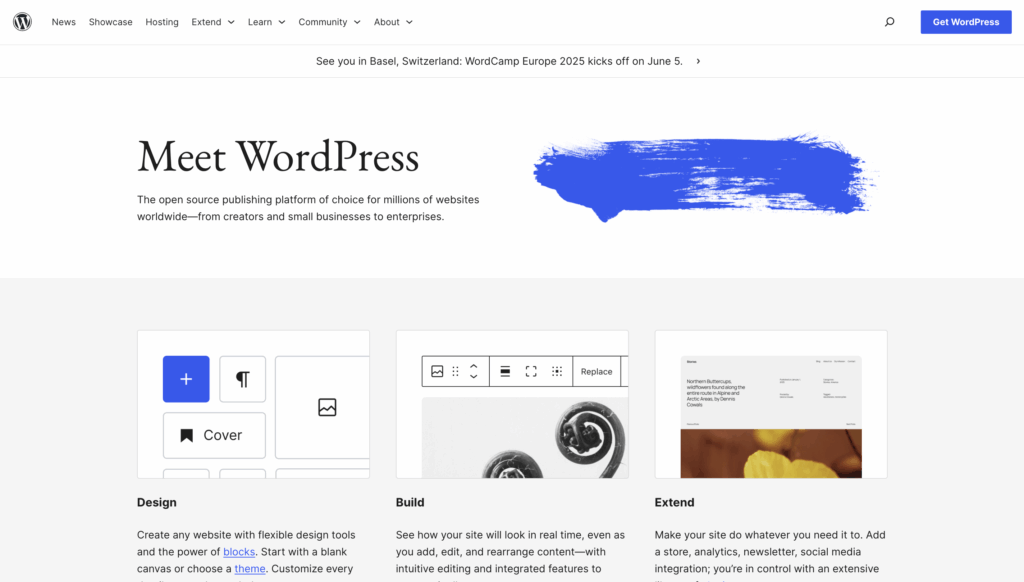
WordPress, Joomla, and Drupal are all popular content management systems (CMS) that can be used to build and manage websites. Before starting the main discussion, I’d like to give a quick summary of them.
- WordPress: The most popular CMS of the entire web. Its ease of use and large community made it the top choice for small businesses.
- Joomla: It was the biggest name before WordPress and probably a more powerful CMS than WordPress. With more features and flexibility, it can be considered for larger businesses and organizations. It still empowers 1.5% of total websites.
- Drupal: A very powerful and flexible CMS with lots of complexity. For large, complex websites with unique needs, it can be a good choice. Drupal is used by like 1.2% of websites.
Market Share
WordPress dominates with a 63.4% market share, indicating its popularity and widespread adoption. Joomla holds a 2.7% share, and Drupal follows with 1.8%, each serving niche needs effectively.
Let’s talk about the market share of each CMS.
First up, WordPress dominates the market with a 61.7% share. You can see how big its impact is on online platforms.
WordPress’s popularity is for many reasons. From its vibrant, helpful community to an extensive range of plugins and themes
Core Similarities
Although they’re three different CMS platforms with various features and benefits, that doesn’t necessarily mean they don’t have common things.
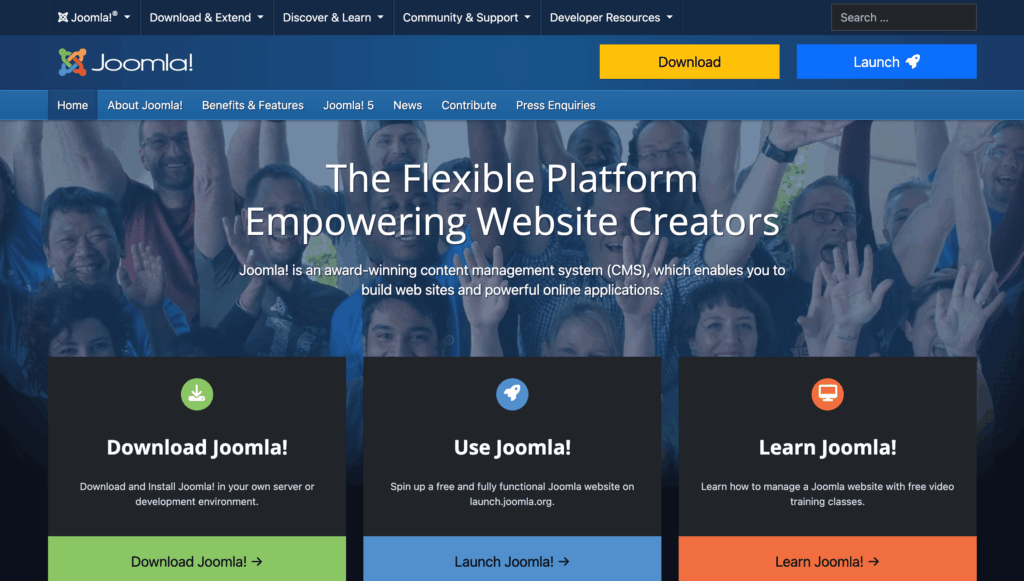
First of all, these three are open-source and built mainly on PHP, utilizing MySQL for database management.
Each platform offers a wide range of templates and add-ons to customize your site. You can tailor those features according to your needs.
Since they’re open-source, you have to pay no license fees. The community helps these platforms to grow with a collaborative approach to development.
Drupal vs WordPress vs Joomla: a detailed comparison
I’m going to write an elaborate comparison based on multiple parameters. Let’s check them one by one.
Ease of Use
WordPress
As a long-time WordPress user, I’m a fan, but I’ll stick to the facts. Even sometimes I ask myself why WordPress is so popular. I’ve been using it for over a decade, and I think its popularity comes down to three things:
- Easy installation
- User-friendly interface
- Beginner-friendly resources
The installation is so easy that you don’t need to worry about it. There are tons of hosting packages that have easy WordPress installation. All you have to do is follow the instructions, which are basically clicking the steps.
To me, the dashboard is very friendly, it’s mostly because I’m too familiar with the environment. But what about new users?
I think it’s friendly for them as well. There’s nothing you can’t understand – easy terms, all organized, and smooth navigation.
On top of all, you can see a pattern that’s very understandable. For post creation, you can see options like All Posts, Add New Post, etc. For pages, you will get options like All Pages and Add New Page. For users? All Users, Add New User. You got the pattern, right?
These are a few examples of how WordPress is easy to operate.
Next, moving into resources. Well, here WordPress is unbeatable.
WordPress has a large collection of resources, and the most interesting part is that most of them are created by the community.
There are countless blog posts, tutorials, guides, YouTube videos, courses, forums, and other resources whenever you need help.
Joomla
Unlike WordPress, Joomla is a little bit harder to operate, but manageable. It’s not new and is one of the top five CMS in the world.
The installation process is not as hard as most of the hosting let it manage with one-click installs.
Although the user interface is structured and friendly, it requires technical knowledge to customize and extend functionality.
Content creation is not as easy as WordPress, but not as hard as well. Meaning, you can create content without too much complexity, and once you’re accustomed to the environment, it will be less complicated.
Joomla’s active community provides helpful tutorials and support, ensuring you’re never stuck. You can also find developers to build custom projects for you.
I must mention that the learning curve is slightly steeper, but you can manage if you are looking for a WordPress alternative.
Drupal

It’s hard for me to be an advocate of Drupal since it’s highly complex and has a higher learning curve, and requires more technical expertise.
First, the installation is not easy, giving beginners a real hard time. If you don’t have a particular level of technical expertise, you can fall into a really overwhelming situation.
While the user interface is favorable for experienced users, it can be challenging for beginners.
For customization, it offers an array of modules so that people can have great control over the extendibility. But again, it requires technical proficiency, especially with programming languages.
You can create custom content types, and there you’ll have more control over content management, and yes, that requires a clear understanding of the technical world.
A limited sphere of tutorials and resources is available. There’s an active Drupal user community, so you can get help when stuck.
Flexibility and Customization
WordPress
WordPress is the most amazing CMS because of its flexibility. To design a website, you can get thousands of WordPress themes, both free and pro.
Now that everything is block-based, there are many options for that – plugins and themes. Full Site Editing themes will make your process even smoother.
I think the best thing about WordPress is its plugins. You can get plugins for almost any need. Be it a simple contact form to complex funnel building, from gallery design to social media connection, you can accomplish a lot with WP plugins.
For highly complex projects, the options may seem limited within WordPress. Well, you can manage, but it will give you a hard time.
For multilinguals, WordPress has amazing options with 200 languages support. But it is fully translatable in around 70 languages, I guess.
Joomla
Is Joomla flexible?
Yes, thanks to its extensive array of features, numerous customizable templates, and a huge library of extensions.
If you go to their extension library, you’ll find tons of resources to use for your business. Everyone has their unique needs. Choose your desired extensions from the list of social display, accessibility, design, payment gateway, forums, emails, you name it.
If you are not a technical person, you might find it easier to go with Joomla since it offers customizable templates. You can edit and modify the templates with fonts, colors, and layouts, all in a user-friendly interface.
Joomla is multilingual. With its over 70 translation packs, Joomla users can easily create websites in their preferred languages.
Since Joomla is an old CMS, it has an active community to help its users. Whenever you need you can find the relevant documentation, tutorial, and support.
Drupal
Drupal works similarly to WordPress with extensions and modules. Many themes and plugins are also available with Drupal to customize your websites.
But one thing to remember is that customization can be challenging and often requires coding skills to add new features. Unlike WordPress, you have to set up and maintain it all by yourself.
Without being a developer, you may fall into an ocean and can’t swim back to the shore. But you can enjoy their environment to build complex projects with proper development knowledge.
What’s the solution to this?
Well, you can hire experienced developers from freelance platforms. Also, there are themes and a module marketplace to continue with what you want to build.
If you scan Drupal websites, you can understand how unique they are. It’s because those sites are customized by veteran developers.
Features and Functionality
WordPress
WordPress is undoubtedly the most feature-rich CMS ever made. For making a simple website or a blog, you can choose this platform without any hesitation. The extending functionality is the key strength of WordPress.
The simplicity of Posts and Pages lets people initiate their creative works without any dilemma. The famous Gutenberg editor gives you the feel for building blocks with just a click and go. You can get plugins for almost any scenario you imagine.
While I’m not going into too many details, here I’m mentioning a few options of what you can expect.
- Highly flexible
- User-friendly
- Ready for SEO
- Easy media management
Joomla
Joomla has so many built-in features that will make your website-building journey simpler. From user management to multilingual support, a lot to discover with this CMS. It offers a more adaptable system, but requires development support for extensions.
These are Joomla’s highlighted specs when checking into it.
- Efficient content management
- Better user management
- Multilingual support
- Extensibility
Drupal
Drupal is a powerful content management system that has tons of features to create your website. Developers will get the maximum benefits since it’s technically advanced. It highly focuses on handling complex data structures and helping in building custom applications.
For functionality, Drupal is opted for complex content structures. While you can customize for complicated systems, it often requires developer expertise to get the optimal output.
You can trust the following features to get started.
- API-First Design
- Content as a Service
- Multisite Support
- Enterprise-Grade Tooling
Themes and Plugins/Extensions
WordPress
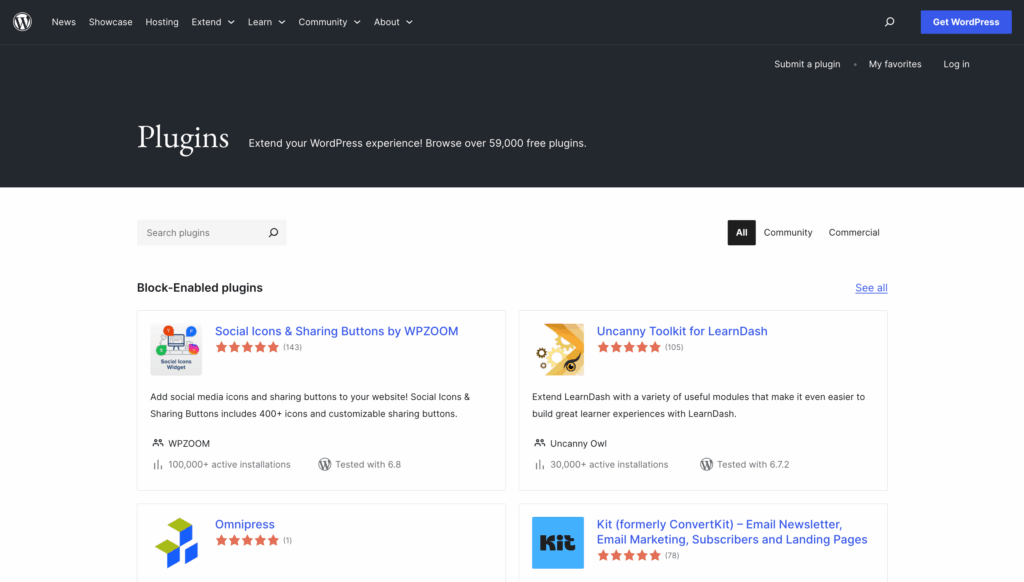
The vast library of themes and plugins, both free and paid options, made WordPress the top choice for content creators and business owners. WordPress has a vast library of themes. Whatever you can imagine, you’ll find a theme for that purpose.
And your possibilities are endless when you step into the world of page builders. From the default Gutenberg editor to dozens of other top-class page builders, you can create websites for your business.
But plugins are the core strength of WordPress, I believe. They have tons (literally) of plugins both free in the official WordPress repository and in independent plugin builders like us.
Joomla
Joomla has a great source of templates and extensions to help you get started faster with your business website. Even third-party developers are contributing continuously to make the platform accessible.
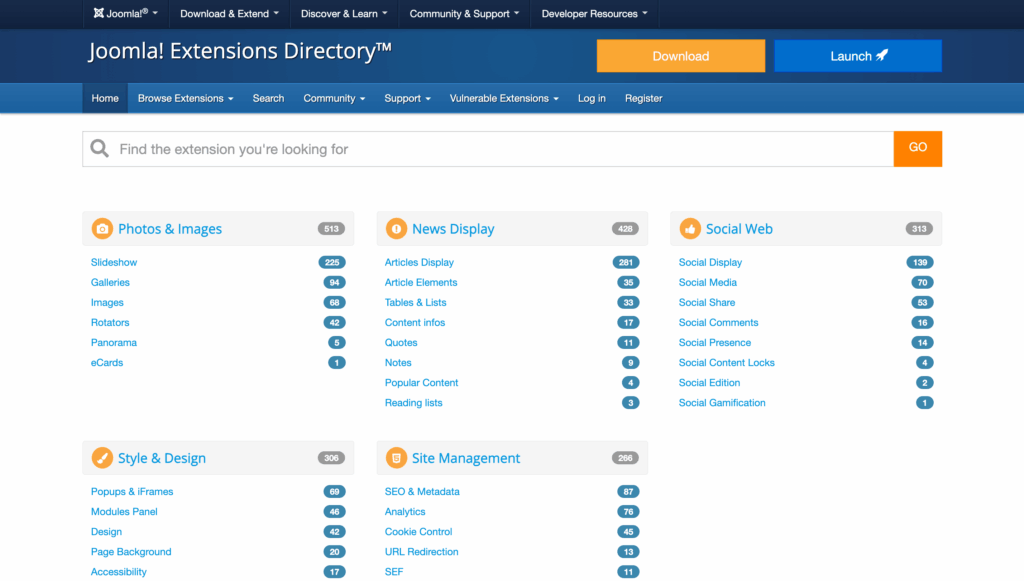
Since Joomla is an open-source platform and you can get templates and extensions with free options, you can give it a try. If you are satisfied with the outcome, then you can consider it as a powerful WordPress alternative.
Drupal
Drupal is largely based on the module and theme system. While it indicates the power of the platform, it also shows its complexity. But all these exist in theory until you try for one of your projects.
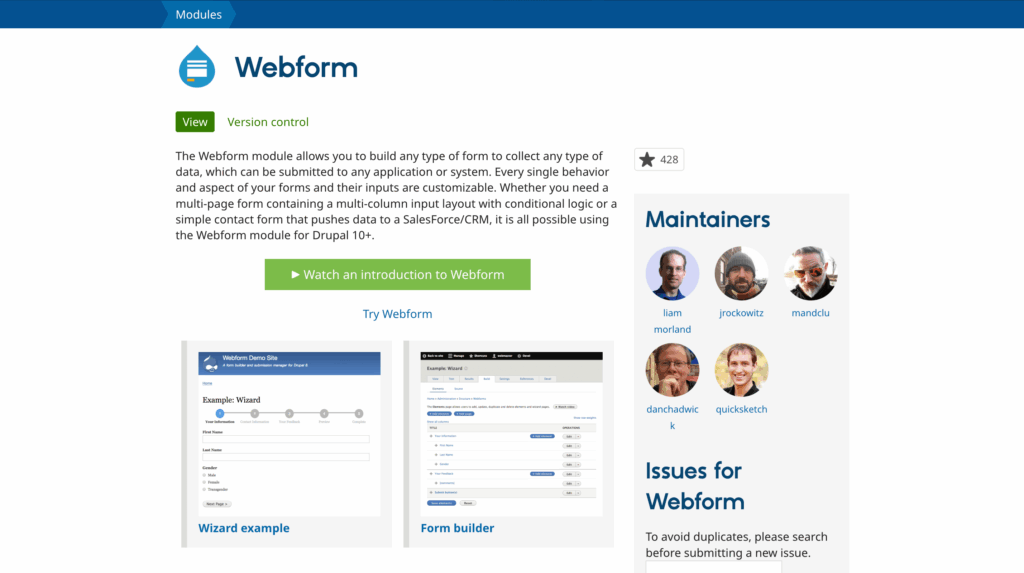
Themes work like WordPress and Joomla, meaning they’re responsible for the visual appearance of your website. But the modules work differently. They add functionality, in a broader meaning, extend core functionality.
Modules make it easier to customize and add features to meet your needs. You need to understand the module system to create a tailored website.
SEO (Search Engine Optimization)
WordPress
WordPress is the most favorite for SEO specialists. The reason? It’s easy to deploy.
For on-page optimization, you can do title optimization, write meta descriptions, and generate SEO-friendly slugs.
But I think the power lies within the power of SEO plugins. As already discussed, the plugin system gives WordPress the core strength to utilize it in small to large projects. SEO is no exception with popular plugins like Yoast, RankMath, All in One SEO, and so on.
Joomla
SEO with Joomla may not be as friendly as WordPress, but you can get your job done.
You can enable “Search Engine Friendly URLs” in the Joomla Global Configuration. With that, you can ensure your URLs are properly optimized for search engines.
Further, you can optimize metadata and set custom titles and descriptions while including keywords in a healthy way.
You’ll find extensions to automatically generate an XML sitemap and submit it to search engines. Additionally, you can apply schema markup to enrich your content and provide richer information to search crawlers.
Mobile responsiveness, technical fixing, on-page optimization, and other SEO practices are also efficiently doable.
Last but not least, a huge list of extensions is available on their official store to boost your SEO game. Go to the SEO category and choose the one you need from tools like SEO-Generator, Tag Meta, and 4SEO.
Drupal
It’s not impossible to apply SEO functionalities with Drupal, but it’s not as direct and straightforward as WordPress. You already know that Drupal provides a way of controlling everything, so SEO is not an exception here. That means you need to have developing skills to implement SEO.
Your starting point could be installing a module called PathAuto. It allows you to change the URLs from node URLs to make them search engine friendly. There are different modules to use to achieve what you want for your SEO game.
From above, you understand how to modify the URLs. You can accomplish similar things by using modules. Want to redirect a page? Implement meta tags? Generate a sitemap? Well, you can do all these and more with the power of modules.
Security
Security issues are a significant concern for the modern web industry. No matter which platform you’re on with your business website, you can’t ignore the possible threats you may face. While WordPress creates updates regularly, Drupal and Joomla deliver when it’s necessary.
WordPress
WordPress is a combination of their own developers and all the contributors spread around the world. That’s how they can easily manage a release cycle, whether it be a quick fix or a large update.
And there are hundreds of ways to maintain security when it comes to your WordPress site. From using a security plugin to purchasing a service package from an agency, you have several options to keep your site safe from malware and harmful attacks.
Joomla
Joomla has core security features, and you can amplify them with best practices. From updating core to applying two-factor authentication, you have ways to measure your website’s security. And there are additional options for security measures, such as hiding the admin panel and using a firewall.
By default, Joomla is secure with clean coding and rigorous testing before releasing an update. On top of that, you can do many other things, let’s say implement a captcha, adjust file permissions, and restrict access.
Drupal
Drupal has a proven track record when it comes to security. They have a dedicated security team that relentlessly works with the community to understand threats. The team often performs analyses of the core project and addresses vulnerabilities whenever they find issues.
If you want to explore various methods to protect your site, you’ll find many. The CAPTCHA module lets you easily add an extra layer of security. The other security measures include Authentication of cron jobs, the Hashcash module (to prevent spam emails), hiding information from visitors, and applying the Honeypot.
In short, Drupal is a highly secure platform with a twist. The twist is that you can’t apply all security measures without some hard work. You need to be a developer or have to ask your programmer friend to lend you a few hours to check the ins and outs.
Community and Support
All platforms have communities with extensive support, making them easily accessible when needing help.
WordPress leads here without any dilemma. The massive community, abundant resources, and helpful support made it the most loved platform.
The official documentation is so rich that anyone can find exactly what they need. Their handbooks for building themes, plugins, and community get-togethers are available for all.
The vast developer network and countless contributors helped make WordPress a place where anyone can get help for complicated to silly matters.
Joomla has an active community and support channels. They may not be as extensive as WordPress, but you’ll get help when needed.
Drupal has a developer-focused community since it’s mainly for developers. The availability of professional support may help you not being stranded.
Cost Considerations
All three are open-source in nature, so you don’t need to pay to use the platforms directly. The costs are associated with relevant things like hosting, themes, plugins, and development. WordPress generally requires lower development costs due to its huge community of developers. Drupal and Joomla, on the other hand, might require more investment since it’s a little bit harder to find experts.
Software cost: Since all three CMS are open-source, you don’t have to pay to download and use them to build your website.
Hosting: WordPress is pretty popular with hosting services. You can get this CMS with any hosting, in addition to WordPress hosting providers. But for Joomla and Drupal, you can easily get good hosting options. So, nothing to worry about!
One thing I must mention here. Almost all the big names in the hosting industry, like Hostinger, Bluehost, and GoDaddy, provide prominent support for WordPress.
Themes and plugins: WordPress was once most popular for themes, and is now popular for plugins. $59 is a popular price when considering theme costs in Themeforest, a popular marketplace for WordPress themes. Divi theme and page builder Lifetime plan costs $249.
You got the idea about themes and page builders. Now let me tell you about plugins. Well, the price of a plugin varies based on the features it offers. More features usually mean a higher price. Fluent Forms, a popular form builder plugin, costs $47/year, Smush Pro image optimization plugin costs $3/mo, and WooCommerc Product Table costs $99/year.
Not to mention that there are plenty of themes and plugins available completely free. Anyone can start their website with a little cost (or even at no cost) in WordPress.
Joomla also offers free themes and extensions. Many popular marketplaces offer the ability to download Joomla templates. JoomShaper, JoomlArt, and YOOtheme are some of the big names in this field.
Not as rich as WordPress and Joomla, but Drupal also has official and third-party options for themes. If you want to choose Drupal, you won’t get lost. That’s all I can say.
Development & maintenance: It solely depends on what you need and to what extent. The development costs vary based on your project size, required time and resources, and complexities.
Which CMS is right for you?
Choosing a CMS depends on your project and comfort level with technology. Let’s break it down to help you decide.
WordPress: People use WordPress for making news sites, online stores, and service-based websites, such as a consultancy. Although everything is possible with WordPress, I’d recommend it for blogs, small businesses, and simple websites.
Joomla: As Joomla is an old contender, it has beend used for all-type of projects in early days. However, I think, Joomla is best for medium-sized websites, membership sites, and multilingual platforms.
Drupal: Due to the recent WPDrama, people are exploring this platform. They even released a fresh CRM to keep up with the hype. Anyway, in my view, Drupal is best for large, complex websites, enterprise-level applications, and projects with unique requirements.
Conclusion
While WordPress is a superb option for most projects, exploring Joomla or Drupal can pay off for specific needs. The whole scenario depends on many factors such as project requirements, technical details, budget, level of necessity, and many other things.
Generally WordPress is ideal for beginners with a lot of cost-effective solutions. Drupal and Joomla cater to more complex and customizable project needs.
If you want to start a personal website or a simple eCommerce store, start with WordPress without hesitation. If you have a big and complex project, you may explore different platforms before making the final decision.
Despite WPDrama, WordPress’s massive community ensures it’s here to stay, with updates like version 6.8 in April 2025 proving its resilience.




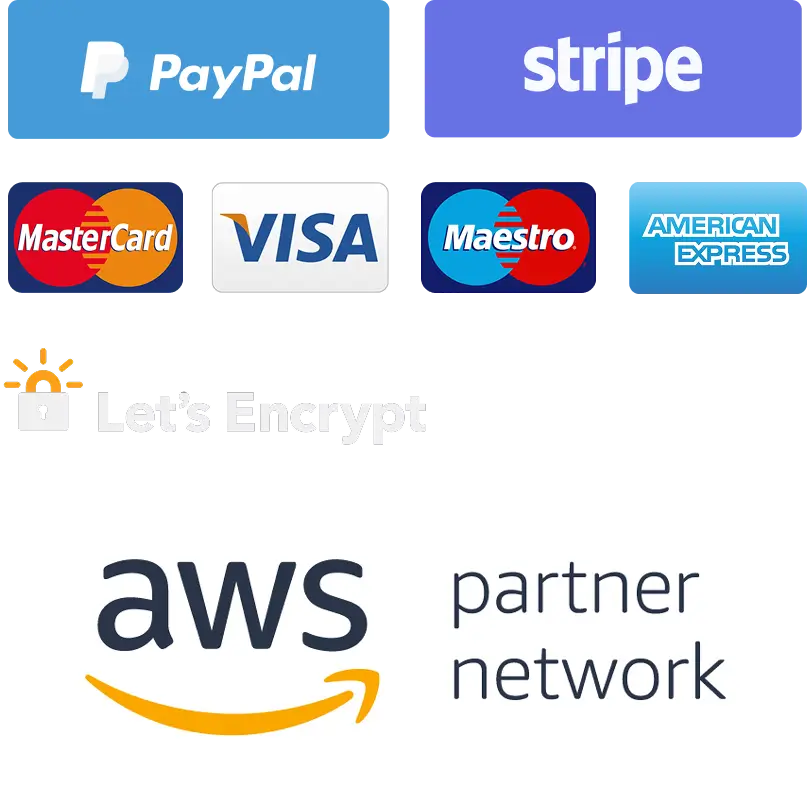
Leave a Reply
You must be logged in to post a comment.